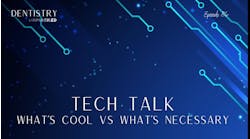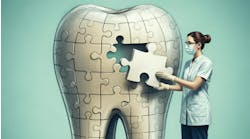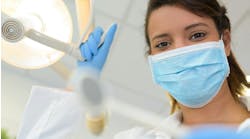by Barry Glassman, DMD
For more on this topic, go to www.dentaleconomics.com and search using the following key words: sleep medicine, dental sleep medicine, sleep disorders, profit center.
I want to bring some reality to the economics of dental sleep medicine, an area for dentists that is being promoted by many as a new profit center in the dental practice. There is no question that adding this valuable service to your armamentarium has the potential not only to improve the quality of lives of many of your patients, but also provide increased income.
Along with the ability to increase services and income, dental sleep medicine provides many new challenges to the dentist that are often ignored or underestimated. Only if these challenges are recognized and conquered will the dentist be in a position to provide a therapy that could be essential to the patient's quality of life.
What is dental sleep medicine?
Sleep medicine is a relatively new specialty of medicine. In a 2005 article, Shepard, et al. state that "the history of the development of sleep medicine in the United States is relatively short and most of the individuals involved with its development are still living." They go on to state: "Until 1975 sleep medicine was deemed ‘experimental' and medical insurance companies routinely denied reimbursement claims." In discussing the development of the specialty of sleep medicine, they conclude that "sleep is viewed as a basic biologic process that affects all individuals and has significant impact on the function of all organ systems."
The International Classification of Sleep Disorders is a 400-page, stand-alone document that was written in 1990 and revised in 2005. Sleep medicine deals with sleep and arousal disorders that include all conditions encountered clinically. It deals with dyssomnias, which are those disorders that involve initiating and maintaining sleep, as well as with parasomnias, which are movements and behaviors that occur during sleep. Obstructive sleep disorders are classified as dyssomnias and represent those disorders resulting from airway obstructions that occur during sleep.
They are relatively common syndromes and by conservative estimates affect 5% of the Western world, but they are often under-recognized despite having substantial morbidity and mortality rates associated with them. Treatment for obstructive sleep disorders ranges from the extremely conservative measures of weight loss and sleep position training to variations of continuous positive airway pressure (CPAP), oral appliance therapy, and surgery. Many patients prefer the concept of oral appliance therapy to either the use of CPAP or surgery. A dentist should then be involved with patient evaluation, insertion, and appliance maintenance as well as managing postappliance insertion complications. Consequently, one might think that oral appliance therapy would be a considerable portion of many dentists' general practices. But this is not the case.
I started teaching dental sleep medicine courses in 2001. Personal communication with many of those I had taught in the early courses exposed many difficulties that general dentists were facing as they attempted to implement dental sleep medicine into their practices. Ignoring those obstacles may lead to unrealistic expectations.
The carrot of economic success
It isn't unusual to see an advertisement refer to the potential economic boom that a course will provide for the participant. This lure of increased financial incentive is common to many course advertisements, including periodontics, cosmetic dentistry, and orthodontics.
Silber states that 30% to 50% of the population over 50 snores. This is often interpolated to 40%. So, if 40% of your adult population snores, and you have a practice with 2,000 active adult patients, 800 of your patients snore. If you treat only 25% of them, and you bundle the workup and appliance fee to a moderate charge of $3,000, then your gross income should increase by $600,000 the first year.
Unfortunately, that is an unrealistic computation. The literature ignores the many challenges that face dentistry. Let's examine some of those challenges.
The physician's bias
Recent decades have seen the line between dentistry and medicine continually blur, as dentists made significant contributions to the care of patients with chronic daily headache, migraine, and facial pain. There was an early bias among sleep physicians against early attempts at oral appliance therapy. Pantino reports that when he began treating with oral appliances it was not only considered experimental, but with limited data and research and no consideration of coverage from the insurance industry and with limited physician support, he may as well have been "practicing witchcraft."
The 1995 landmark study by Schmidt-Norwara opened the door to the need for dentistry and medicine to work synergistically and pointed out that as health-care providers, we are challenged to acknowledge the necessity for interdisciplinary communication. This early bias is complicated by the fact that obstructive sleep disorders are indeed a medical disorder. Obstructive disorders are a continuum of disorders that start with snoring.
Therefore, snoring should not be treated without a medical diagnosis, and that diagnosis should be done by a physician. In spite of the tremendous improvements in oral appliance therapy, the fact that oral appliances are usually preferred by patients over the alternatives of CPAP or surgery, and the fact that the Academy of Sleep Medicine has mandated by policy that some patients not only can but in some cases should be treated or given oral appliance therapy, physician bias against oral appliances still exists.
It therefore isn't enough for dentists to know just the basics of sleep medicine and oral appliances. Dr. Schmidt-Norwara recently suggested that "dentists who offer this service need to become acquainted with the multifactorial nature of sleep medicine to serve their patients better and to facilitate their interaction with other sleep medicine clinicians." A high level of mutual respect and open communication is required for the medical and dental professions to properly triage and treat patients. In a position paper on practice parameters by Kushida, et al., it is stated that oral appliances should be delivered and followed by qualified dental personnel "who have undertaken serious training in sleep medicine and/or sleep-related breathing disorders with focused emphasis on the proper protocol for diagnosis, treatment, and follow up."
But there's more than the science of sleep medicine
In order to be successful in incorporating dental sleep medicine into your practice, understanding the science of sleep medicine and possessing the ability to insert oral appliances is not enough. The art of implementing the science requires a different skill set than was required to develop a general dental practice.
In order to be successful, dentists must have strong communication skills. For the most part, general dentists can work within their own office walls and choose those specialists with whom they would like to work. In sleep medicine, dentists must immediately work to develop relationships of trust and mutual respect with physicians with whom they may have no past relationship and with whom they have had limited contact. Furthermore, because physicians hold the bias discussed earlier in this paper, they will often have to be educated and motivated to refer patients for oral appliance therapy. There is also the matter of "management" and the potential for failure. The dental model of practice doesn't usually involve "managing" disease; we treat it and cure it. Obstructive disorders can't be "cured," a concept I have found not readily accepted by some dentists. Dentists need to develop a new mindset and a new definition of success for the practice of dental sleep medicine. They must learn that success cannot be determined with an explorer or depend totally on the polysomnogram results. They must also realize that some patients will be unable to wear their appliances. Dentists must quell their disappointment and acknowledge that although they have rendered the best possible care, there are factors beyond their control that impact the success of oral appliance therapy. This potential for failure should not dampen their enthusiasm. Fear of failure should not prevent them from helping many other patients. Making this realization and sharing this information with the patient prior to treatment is a total change in the model that dentistry routinely utilizes.
There is also the obstacle of postinsertion management. The oral appliance helps maintain the airway during sleep by creating an external splint, resulting in an increased tonic tone to the relaxing pharyngeal musculature. In order to do this, there is a strain placed on the muscles of mastication, as well as the temporomandibular joint itself. General dentists are not well trained in joint anatomy, physiology, nor in the treatment of joint dysfunction. These common complications will sometimes frustrate the dentist who may not be trained in the ability to diagnose, treat, or manage these adverse effects on the joints or muscles. This frustration has the potential to cause the dentist to stop treating with oral appliances. Training in these areas of treatment is readily available, and will allow the dentist to manage these complications and make wise risk/benefit decisions concerning the continued use of the oral appliance.
The most common adverse effect is occlusal changes. Dentistry has long emphasized the role of occlusion, and it is difficult for the dentist to make an informed risk/benefit decision if that role is considered more important than the resolution of the patient's obstructive disorder. Ferguson states, "This presents a clinical dilemma when the patient is unconcerned about the occlusal changes and refuses to abandon the appliance citing that the perceived benefit of treatment outweighs the dentist's concern with the altered occlusion." Dental malocclusions created by oral appliance therapy may have no or limited effect on the patient's esthetics or function. It may be more beneficial for the patient to continue to wear his or her appliance despite the occlusal changes. It is counterintuitive for the dentist to do anything that creates a malocclusion, but this may be in our patient's best interest. This is a difficult concept for dentistry.
A vast bite-wing conspiracy?
Is the promise of economic gain, then, a conspiracy?
The answer is simple. Yes, it is a conspiracy if there is some implication that implementing dental sleep medicine is as simple as finding patients in your office who snore and treating them with oral appliances that you fabricate easily with impressions and bite registrations sent to a lab.
There are real challenges that face dentistry in the field of dental sleep medicine. These challenges include:
- Becoming a serious student of sleep medicine
- Educating your medical colleagues about the potential service you can provide their patients who may benefit from oral appliance therapy
- Understanding the need to manage patients and understanding their role as key players on the treatment team
- Learning how to communicate with local sleep labs and physicians by keeping them in the loop and referring patients back to them for post-treatment evaluations
- Establishing reasonable fee structures and understanding the need to process claims through medical insurance in order to get the most coverage for your patients
- Learning more about the craniomandibular structures you are compromising in order to support a compliant airway
- Carefully reconsidering some of your occlusal concepts that will prevent your potential bias from keeping patients from treatment for this serious disorder that is associated with substantial morbidity and mortality rates
Ninety percent of OSA remains undiagnosed. Our patient load would be well served if all dentists had a better understanding of sleep disorders. Our profession and our patients would benefit if all dentists were taught the basics of sleep medicine and consequently screened their patients. But more intensive study on many levels and a commitment to consider the model changes discussed are required before the dentist can provide oral appliance therapy and create another income source in his or her office.
So what is a "vast bite-wing" conspiracy? The conspiracy is on the part of those who may gain economically in the short run by having dentists construct snoring appliances for those patients who snore (even if it means without proper diagnosis) or by encouraging dentists to take courses because of the perceived economic gain without recognizing the obstacles to that end. Furthermore, the conspiracy often encourages the front-end purchase of equipment that is not required to perform dental sleep medicine; again, in the long run, this frustrates the general dentist who is not aware of the obstacles that prevent the successful implementation of dental sleep medicine in his/her practice.
Many Level I to V studies have now been completed to demonstrate over and over again the potential of oral appliance therapy to be successful in mild, moderate, and even severe sleep apnea. Certainly, oral appliance therapy has been implemented into many dental practices successfully. Some dentists around the country have actually limited their practices to dental sleep medicine. The obstacles can be overcome. But before they can be overcome, they have to be recognized and acknowledged. Then a plan can be made to overcome each obstacle.
It is essential, then, that the "bite-wing conspiracy" not result in frustration and the dentist deciding not to pursue dental sleep medicine. Those who have accepted the challenges and overcome the obstacles have placed themselves in a position to provide a potentially life-altering and life-saving treatment modality. The diligent dentist has the opportunity to add not only a new stream of income for his practice, but also a new quality of life for his or her patients.
See the bibliography for this article at www.dentaleconomics.com.
Barry Glassman, DMD, maintains a private practice in Allentown, Pa., which is limited to chronic pain management, temporomandibular joint dysfunction, and dental sleep medicine. He is a Diplomate of the American Academy of Craniofacial Pain, a Fellow of the International College of Craniomandibular Orthopedics, a Fellow of the Academy of Dentistry International, and a Diplomate of the American Academy of Pain Management. He is on staff at the Lehigh Valley Hospital where he serves as a resident instructor of Craniofacial Pain and Dysfunction and Dental Sleep Medicine. He is a Diplomate of the Academy of Dental Sleep Medicine, and is on staff at the Sacred Heart Hospital Sleep Disorder Center. He was recently named medical codirector of the St. Lukes Hospital Headache Center.





